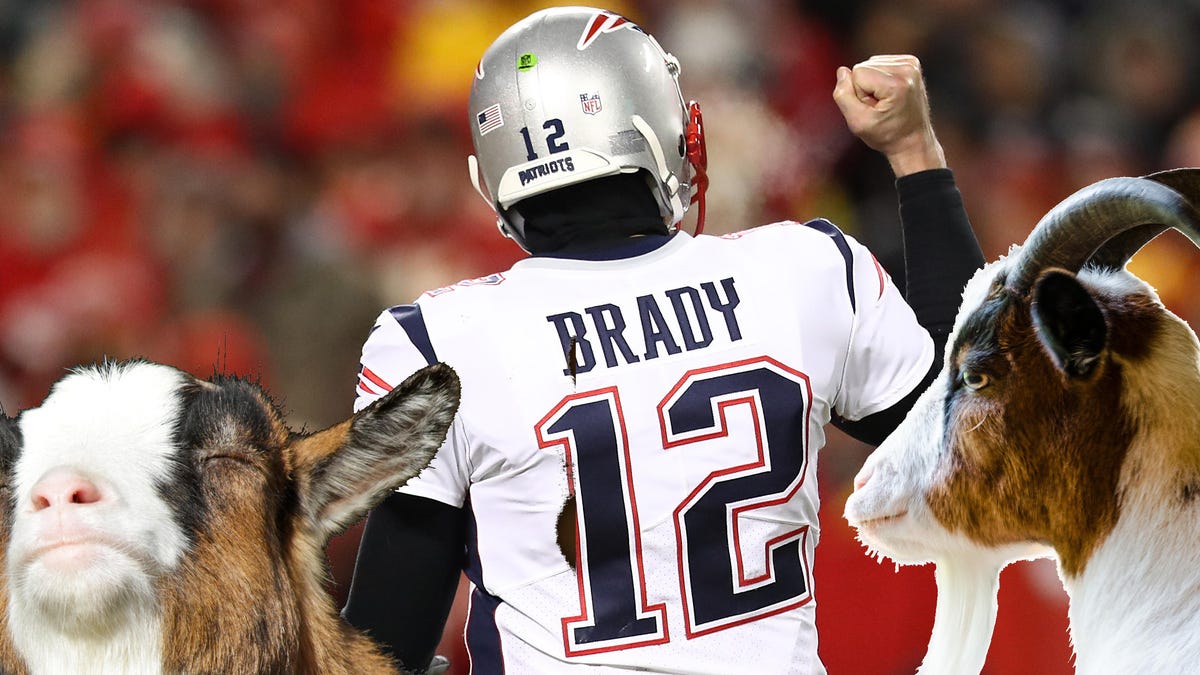Twitter's 🐐 emoji record belongs to the Patriots' Tom Brady
The social media giant says Tom Brady is the G.O.A.T., no ifs, ands or baas about it.

Being the very best in the world at a professional sport means sweeping up all the accolades, winning all the championships, earning all the MVPs and willing yourself to victory time and time again. And for the chosen few that work their way up the mountain, all the way to the top, to become the best that ever walked the Earth, a special title awaits.
The Greatest Of All Time.The G.O.A.T. 🐐
After Tom Brady willed the Patriots over the line in the AFC Championship Game against the Kansas City Chiefs on Jan. 20, Twitter caught figurative fire in a conflagration of tweets that erupted across the platform. The tweet storm saw a steady stream of 🐐 emoji begin to flow from the fingers of tweeters everywhere. Brady's performance, once again, had people talking about whether or not he was the G.O.A.T.
It had me thinking: Would the all-time record for goat emojis be broken?
and id love to get comment from @Twitter about whether or not the all-time goat emoji record was broken todayhttps://t.co/uSyTqY9aMm
— Jackson Ryan 🙏 (@dctrjack) January 21, 2019
I thought it was a lock. A sure thing. As sure as the sun rises every day. Yet again, a Brady masterclass to take the Patriots to another Super Bowl, their ninth in 18 seasons? That would solidify the 41-year-old Brady as the Greatest Of All Time, and Twitter would back that up.
But I was wrong. Twitter provided CNET with the statistics for goat emojis tweeted in a 24-hour time span and I was as shocked as New Orleans Saints' fans after a horrendous missed call. Brady's AFC Championship game heroics only saw the third-most 🐐 emojis of all time with 161,000 tweets on Jan. 20, 2019.
Twitter qualified the numbers with a slight caveat: They counted the number of tweets with goat emoji -- not the number of goat emoji overall. If a tweet had one 🐐 or hit the limit of 140 🐐s, it still counted as a single tweet. (A single emoji counts as two characters.) I think that's fair.
Slipping in at fifth was Serena Williams' loss to Garbiñe Muguruza, where the tennis G.O.A.T racked up 116,000 emojis. Many tennis commentators consider Williams the best female to ever play the game and her record of 23 Grand Slam titles is the highest ever in the Open Era.
At the top end, beating out Brady and the Patriots for second place was an entirely different sport all together. Basketball.
The Cleveland Cavaliers winning the NBA Finals in 2016 saw the fourth biggest day of goat tweets.
The Golden State Warriors breaking the single season record for most wins in an NBA season -- they went 73-9 -- saw Twitter notch up its second-most 🐐 emojis in history at 249,000 on April 13, 2016. For those playing at home, the Warriors didn't win the NBA Championship that season, falling to the Cleveland Cavaliers and LeBron James. Coincidentally, that winning NBA Finals performance from LeBron ranked at fourth place with 134,000 🐐s.
But you came here for first place. Numero Uno. The G.O.A.T. of G.O.A.T.s. The person who has ascended the mountain like their caprine counterparts to be the G.O.A.T. of their chosen sport and the emoji field.
And even though Brady's heroics on Sunday night didn't see him reach the pinnacle of 🐐 emojis, he couldn't be denied top place, in what some may consider an omen for Super Bowl LIV.
The New England Patriots Super Bowl LI comeback against the Atlanta Falcons -- the largest comeback in Super Bowl history -- saw the most goat emojis tweeted ever. I'm going to go out on a completely unscientific limb here and say that Brady's performance in that game, which broke Super Bowl records for completed passes, yardage and earned him the MVP might have something to do with that.
With 333,000 🐐s in a single day, Brady's comeback goes down as Twitter's biggest day for the emoji ever and (sadly, for this Philadelphia Eagles fan) solidifies Tom Brady as the 🐐.
Now, look, yes -- you're right. We can't go making grand sweeping statements like that just because Twitter statistics show us that day had the most goat emojis tweeted ever. What if there was a goat festival on that day? Or goat's milk was recalled? But to that I say, sorry Joe Montana, find it within your heart to believe. The coincidences are too great to ignore.
Twitter hath spoken.
In offline conversation, Brady shares the G.O.A.T. title with stars across a myriad of sports like Michael Jordan, Lionel Messi, Sugar Ray Robinson, Serena Williams, Usain Bolt, Roger Federer and Australian spinner Nathan Lyon. But the stats also demonstrate the emergence of emojis in the past decade has changed the way that we communicate with each other online, often where the most heated debates about the Greatest of All Time take place.
Although created in 1997 by Japanese telecom giant NTT Docomo, emoji rose to prominence in the West only after they were added to Unicode, the computer standard for handling text in the world's writing systems, in 2010. Now you can't even scroll for five seconds without running into one. But their context and meaning varies greatly across the globe. If the Patriots can snag another Super Bowl on Feb. 3, there will only be one meaning for 🐐.
Thomas Edward Patrick Brady, Jr.
If you want to see him do it all again -- and maybe even break another record -- you can find out how to watch the Patriots take on the Los Angeles Rams in Super Bowl LIV with CNET's handy guide.
CES 2019: See all of CNET's coverage of the year's biggest tech show.
Tech Enabled: CNET chronicles tech's role in providing new kinds of accessibility.

